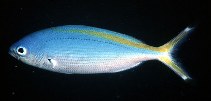| Family: |
Caesionidae (Fusiliers), subfamily: Caesioninae |
| Max. size: |
35 cm TL (male/unsexed) |
| Environment: |
reef-associated; marine; depth range 2 - 25 m, non-migratory |
| Distribution: |
Indian Ocean: Red Sea to the Arabian Sea. |
| Diagnosis: |
Dorsal spines (total): 10-10; Dorsal soft rays (total): 14-15; Anal spines: 3-3; Anal soft rays: 12-12. With 4-5 scales on cheek; 21-24 predorsal scales; scaled dorsal and anal fins; narrow scaleless zone at dorsal midline interrupting Supra-temporal band of scales. Upper peduncular scale rows usually 11 (10-11); lower peduncular scale rows usually 14 or 15 (13-15). Most of body light to silvery blue, paler ventrally. Black blotch at the tip of each caudal-fin lobe bordered proximally by a white band. Presence of a small process on each ventrolateral surface of basioccipital for attachment of Baudelot's ligament. Post maxillary process single; posterior end of maxilla blunt. |
| Biology: |
Inhabits coastal areas, primarily on coral reefs. Forms large midwater aggregations and feeds on zooplankton. Oviparous, with numerous, small pelagic eggs (Ref. 402). |
| IUCN Red List Status: |
Least Concern (LC); Date assessed: 28 June 2018 Ref. (130435)
|
| Threat to humans: |
harmless |
Source and more info: www.fishbase.org. For personal, classroom, and other internal use only. Not for publication.
